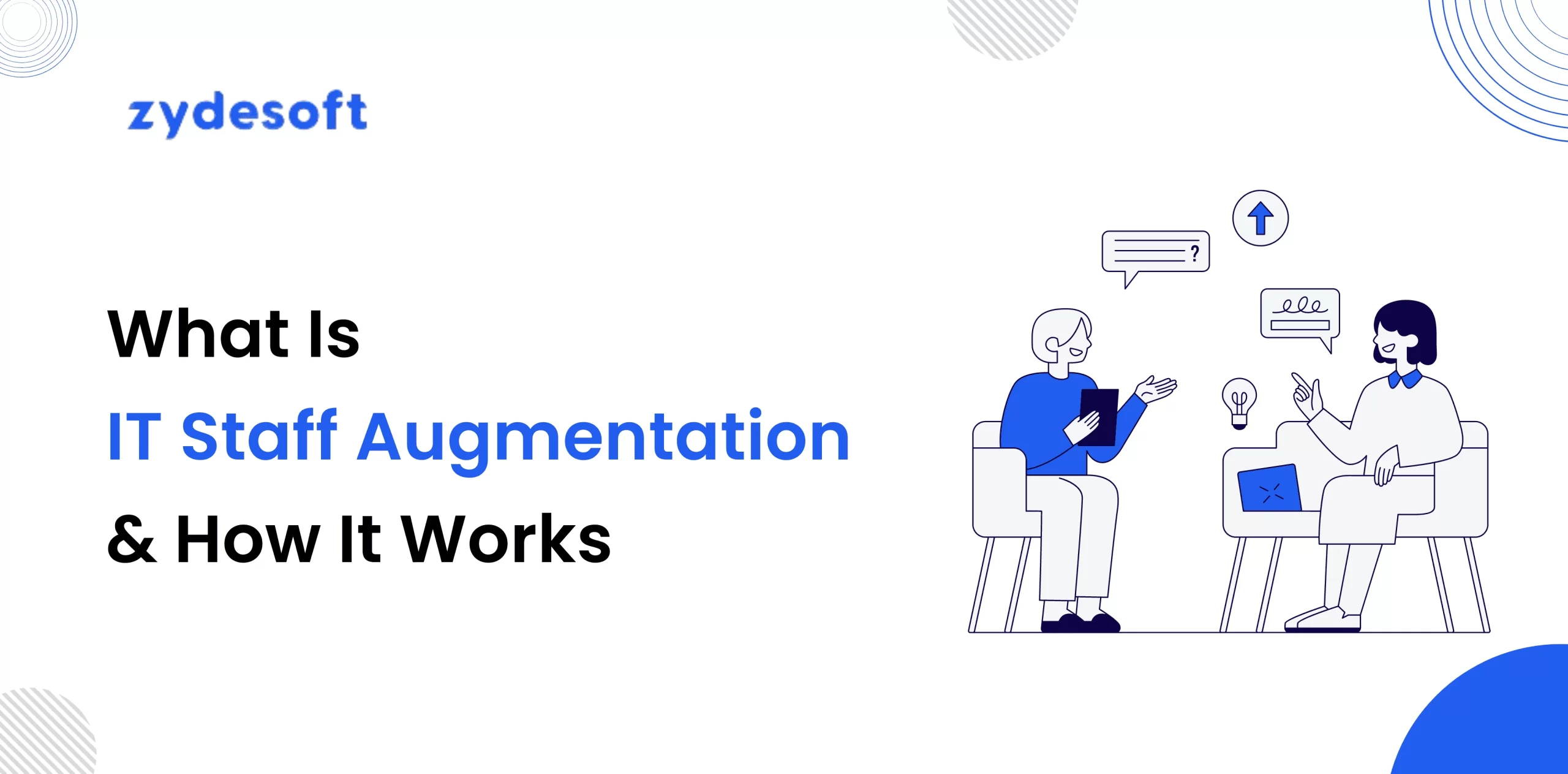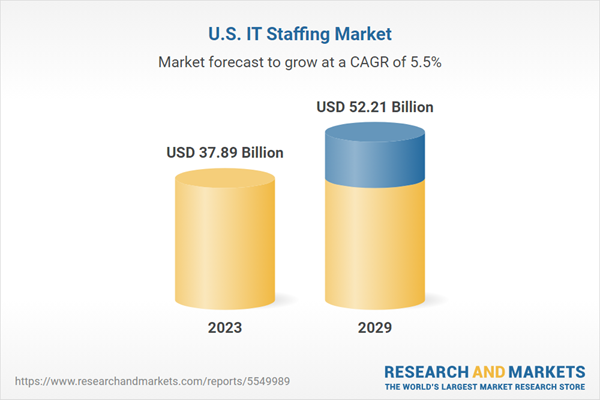
One of the best ways for IT companies to scale their workforce efficiently is through IT staff augmentation. This flexible hiring model allows businesses to bring in skilled professionals as needed without the long-term commitment of full-time employees.
The demand for IT staff augmentation services is growing rapidly. The U.S. IT staffing market was valued at USD 37.89 billion in 2023 and is expected to reach USD 52.21 billion by 2029, with a CAGR of 5.49%. This surge highlights the increasing reliance on flexible workforce solutions.
With IT staff augmentation, companies can optimize costs, speed up hiring, and access specialized talent. Whether it’s filling skill gaps, expanding teams, or adapting to new project demands, this approach offers the agility needed to stay ahead. It’s a smart, scalable solution that ensures businesses have the right expertise at the right time—without the overhead of permanent hires.

Staff augmentation is a flexible outsourcing strategy that involves hiring tech talent globally to bridge the gap between the existing skills of your workforce and the skills needed to complete your projects successfully. Unlike traditional hiring, this model is typically quick to deploy and can be scaled up or down easily based on project needs.
For Example: Imagine your company is launching a new AI-powered financial tool aimed at helping small businesses manage their finances better. You already have a project manager and two senior software engineers on your team, but to meet your ambitious six-month launch deadline, you need an additional five specialists skilled in machine learning, data security, and UI/UX design.
The challenge is that hiring such specialized talent typically takes several months due to the competitive market, potentially delaying your product release and affecting your competitive edge.
By opting for staff augmentation, you can quickly onboard the needed specialists within a few weeks. This not only keeps your project on track for a timely launch but also integrates top-tier expertise without the long-term commitment of full-time hires. Once your financial tool is successfully launched, these augmented staff members can transition off the project without the complexities of permanent employment termination, making it a flexible and efficient solution.
Staff augmentation stands out by offering a blend of control and flexibility not typically found in traditional hiring or outsourcing. While traditional hiring focuses on long-term employment, staff augmentation is inherently temporary and project-specific. Unlike complete outsourcing, it keeps the core project activities under your control but without the overhead associated with permanent employment.
Staff augmentation can be segmented into various models for business. By choosing the right staff augmentation models, companies can efficiently scale their workforce while maintaining control over their projects.
| Commodity-based Augmentation | Focuses on roles that do not require specialized skills or extensive training. Tasks are more general and can be quickly learned. | Data entry, basic administrative tasks, and customer support. |
| Skill-based Augmentation | Requires specific skills but not high expertise. Staff are needed for their technical ability and some training or experience. | Web development, network administration, basic software development. |
| Highly-skilled Augmentation | involves roles requiring advanced knowledge and expertise. These positions often need significant experience and specialized skills. | AI development, cybersecurity, advanced data analytics. |
Here are some common scenarios where staff augmentation shines:
When you have a well-defined project with a fixed deadline, staff augmentation lets you bring in specialists to hit the ground running. This is especially helpful if your current team doesn’t have the bandwidth to take on extra work.
If your existing team is swamped, staff augmentation provides much-needed support. It allows you to tackle your current workload while ensuring ongoing projects stay on track.
Does your team lack a particular expertise? Staff augmentation lets you target specific skill sets. You can temporarily hire qualified professionals to bridge the knowledge gap and complete tasks efficiently.
Launching a new product or service often requires a surge in manpower. Staff augmentation helps you scale your team rapidly, allowing you to bring your ideas to market faster.
Flexibility and Scalability: The IT landscape is constantly evolving, demanding adaptability. Projects can fluctuate in size and scope, requiring teams to adapt quickly. Staff augmentation allows IT departments to scale their workforce up or down as needed, ensuring they have the right resources for the job.
Access to Specialized Talent: IT projects often require a unique blend of technical skills. Finding and hiring permanent staff for every specialized need can be challenging and time-consuming. Staff augmentation provides access to a wider talent pool, enabling businesses to find the exact expertise they require for a particular project.
Cost-Effectiveness: Hiring permanent IT staff comes with a significant financial burden, including salaries, benefits, and overhead costs. Staff augmentation offers a more cost-effective solution. Businesses only pay for the skills they need for the duration of the project, reducing overall expenses.
Reduced Time to Market: In today’s competitive IT landscape, time to market is crucial. Staff augmentation allows businesses to quickly assemble teams with the necessary expertise, expediting project completion and getting products or services launched faster.
Staff augmentation offers a flexible way to scale your workforce and fill skill gaps. But with various service options, choosing the right fit can be tricky. Let’s explore the common types of staff augmentation services to help you make an informed decision:
Consider these factors when selecting a staff augmentation service:
By understanding these service types and considering your project needs, you can choose the staff augmentation solution that best fits your goals and budget.
| Feature | Staff Augmentation | Independent Contractors (Freelancers) | Dedicated Teams |
| Focus | Fills specific skill gaps or temporary needs | Specific tasks or projects | Long-term projects requiring a focused team |
| Team Structure | Individual specialists or small teams | Individual freelancer | Dedicated team assigned to your project |
| Management Responsibility | You manage project direction, vendor manages staff | You manage everything (project, freelancer) | Vendor manages team, you provide project direction |
| Engagement | Varies based on need (short-term to ongoing) | Defined project scope or hourly basis | Long-term contracts |
| Cost | Potentially lower due to avoiding full-time overhead | Can be variable depending on freelancer rates | May be cost-effective compared to in-house staff |
| Control | More control over daily tasks (compared to dedicated teams) | Most control over project and freelancer | Less control over day-to-day work, but more oversight on project milestones |
Staff augmentation offers several compelling benefits of IT staff augmentation, making it an attractive solution for businesses seeking flexibility, cost savings, and access to specialized talent.
IT staff augmentation can offer flexibility and expertise to companies looking to enhance their teams with specialized talent. However, like any approach, it comes with its own set of advantages and disadvantages. Here’s a detailed look at the pros and cons:
Access to Specialized Skills: Staff augmentation allows companies to access specific skills on-demand, filling gaps in their existing teams without the long-term commitment of hiring permanent staff.
Scalability and Flexibility: Augmentation provides the flexibility to scale your workforce up or down based on project requirements, making it easier to adapt to changing business needs.
Cost-Effective: It can be more cost-effective than hiring full-time employees, especially when the need for additional staff is temporary or project-specific. You save on recruitment, benefits, and other employment costs.
Reduced Hiring Time: Augmentation speeds up the hiring process, as companies can leverage the staffing agency’s resources to find qualified candidates quickly.
Focus on Core Business: By outsourcing certain functions or projects, your core team can focus on strategic goals and core business operations.
Privacy and Security Concerns: Using external teams can lead to privacy risks since they will access sensitive data. It’s important to conduct regular security checks and have strong Non-Disclosure Agreements in place to protect your information.
Management Challenges: Managing a team that isn’t physically present can be challenging. Effective communication and management strategies are essential to keep both in-house and augmented staff aligned and projects on track.
Quality Risks: Cutting costs might lead to hiring less qualified staff, resulting in higher long-term costs due to delays and potential security issues. Ensuring quality involves strict checks and verifying the past performance of the staff you hire.
Skill Gaps: If augmented staff don’t meet project requirements, replacing them quickly can lead to poor choices. A thorough initial selection process helps avoid this by ensuring the staff’s skills match your needs from the start.
Staff augmentation is a strategic approach that allows IT companies to adapt quickly to project demands by hiring skilled talent on an as-needed basis. This model provides numerous advantages including access to a global talent pool, flexibility, cost-efficiency, and reduced hiring times, which are essential for maintaining competitiveness in the fast-paced tech industry.
With various service types such as on-site, remote, project-based, and team-based augmentation, organizations can choose the most suitable option based on their specific project requirements, duration, budget, and company culture. This flexibility helps businesses efficiently scale their operations, manage costs, and enhance productivity without the long-term commitments associated with traditional hiring.
While staff augmentation offers significant benefits, it also presents challenges such as potential management difficulties, cultural integration issues, security risks, and dependency on external providers. Companies must carefully assess these factors to effectively integrate staff augmentation into their workforce strategy.
Ultimately, staff augmentation stands out as a popular choice in the IT industry due to its ability to provide immediate access to necessary skills, allowing companies to quickly respond to market changes and opportunities while focusing on their core business operations.